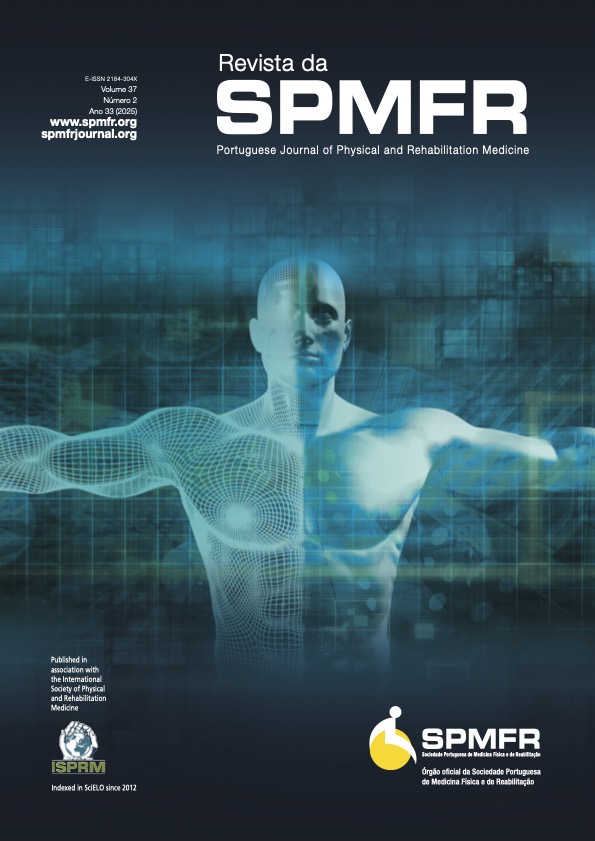The Relevance of Hand Mobility and Functionality Surveillance in Patients with Systemic Sclerosis
DOI:
https://doi.org/10.25759/spmfr.532Keywords:
Scleroderma, Hand, Rehabilitation, Quality of Life, FunctionAbstract
Introduction: Systemic sclerosis causes skin thickening, Raynaud’s phenomenon, visceral damage, and musculoskeletal issues. Hand impairment, affecting about 90% of patients, limits mobility, dexterity, and grip strength, significantly impacting daily life, with few treatment options. This study aims to characterize hand function in patients with Systemic Sclerosis and, secondarily, to describe those undergoing rehabilitation and using assistive devices.Material and methods: This cross-sectional observational study included Systemic Sclerosis patients from Rheumatology service care meeting 2013 American College of Rheumatology/European League Against Rheumatism Systemic Sclerosis criteria. Sociodemographic and clinical data were collected through anonymous questionnaires. The exclusions were based on the inability to contact the patient, refusal to participate in the study due to transportation costs, and incompatibility with work schedules. Data included age, gender, education, employment, disease subtype, systemic involvement, symptom duration and diagnosis duration. Hand rehabilitation and assistive device usage were assessed. Additionally, hand and fingers’ skin thickness was assessed using the modified Rodnan Skin Score. Hand mobility was evaluated by the Modified Hand Mobility in Scleroderma, and Grip was measured by Jamar dynamometer. Disability status, quality of life and hand function were appraised using the Health Assessment Questionnaire, Medical Outcomes Short Form-36 and Cochin Hand Functional Scale, respectively. The data were analyzed using the International Business Machines Corporation Statistical Package for the Social Sciences software, version 29 (International Business Machines Corporation, 2023). We performed descriptive statistics. A linear regression for Cochin Hand Functional Scale score included variables marginally or significantly associated in univariate analysis, adjusting for various factors.
Results: A total of 32 patients participated, predominantly female, with Limited Systemic Sclerosis. Few used assistive devices (18.8%) or received hand rehabilitation (14.3%). Cochin Hand Functional Scale median score was 5.0, with 10.5 for the third quartile, indicating low functional compromise, and only four patients had this scale score H 25. Hamis score was significantly associated with Cochin Hand Functional Scale (adjusted R-squared = 0.80), explaining 80% variability.
Conclusion: This study underscores the need for continuous assessment of hand mobility and function, as well as the implementation of a multidisciplinary approach in the management of patients with Systemic Sclerosis.
Downloads
References
Sandqvist G, Eklund M, Alesson A, Nordenskiöld U. Daily activities and hand function in women with scleroderma. Scand J Rheumatol. 2004;33(2):102-7. doi:10.1080/03009740410006060.
Young A, Namas R, Dodge C, Khanna D. Hand impairment in systemic sclerosis: various manifestations and currently available treatment. Curr Treat Options Rheumatol. 2016;2(3):252-69. doi:10.1007/s40674-016-0052-9.
Parodis I, Girard-Guyonvarch C, Arnaud L, et al. EULAR recommendations for the non-pharmacological management of systemic lupus erythematosus and systemic sclerosis. Ann Rheum Dis. 2023;ard-2023-224416. doi:10.1136/ard-2023-224416.
Kwakkenbos L, Carrier ME, Welling J, et al. Randomized controlled trial of an internet-based self-guided hand exercise program to improve hand function in people with systemic sclerosis: the Scleroderma Patient-centered Intervention Network Hand Exercise Program (SPIN-HAND) trial. Trials. 2022;23(1):994. doi:10.1186/s13063-022-06923-4.
Pearson DR, Werth VP, Pappas-Taffer L. Systemic sclerosis: current concepts of skin and systemic manifestations. Clin Dermatol. 2018;36(4):459-74. doi:10.1016/j.clindermatol.2018.04.004.
Sandler RD, Matucci-Cerinic M, Hughes M. Musculoskeletal hand involvement in systemic sclerosis. Semin Arthritis Rheum. 2020;50(2):329-34. doi:10.1016/j.semarthrit.2019.11.003.
Stöcker JK, Schouffoer AA, Spierings J, et al. Evidence and consensus-based recommendations for non-pharmacological treatment of fatigue, hand function loss, Raynaud’s phenomenon and digital ulcers in patients with systemic sclerosis. Rheumatology (Oxford). 2022;61(4):1476-86. doi:10.1093/rheumatology/keab537.
Erol K, Gok K, Cengiz G, Ozgoomen S. Hand functions in systemic sclerosis and rheumatoid arthritis and influence on clinical variables. Int J Rheum Dis. 2018;21(1):249-52. doi:10.1111/1756-185X.13044.
van den Hoogen F, Khanna D, Fransen J, et al. 2013 classification criteria for systemic sclerosis: an American College of Rheumatology/European League Against Rheumatism collaborative initiative. Ann Rheum Dis. 2013;72(11):1747-55. doi:10.1136/annrheumdis-2013-204424.
Azevedo PM, Sanson ES, Skare TL, Dos Santos TA, Martin P. The Brazilian version of the Hand Mobility in Scleroderma (HAMIS) test: translation and validation. Adv Rheumatol. 2019;59(1):51. doi:10.1186/s42358-019-0093-5.
Chiari A, Sardim C, Natour J. Translation, cultural adaptation and reproducibility of the Cochin Hand Functional Scale questionnaire for Brazil. Clinics (Sao Paulo). 2011;66(5):731-6. doi:10.1590/S1807-59322011000600011.
Santos RA, Rebelo L, Dias FC, Rosa CM, Queiroz MV. Health Assessment Questionnaire (versão curta): adaptação para língua portuguesa e estudo da sua aplicabilidade. Acta Reumatoi Port. 1996;21:15-20.
Ferreira PL. Development of the Portuguese version of MOS SF-36. Part I. Cultural and linguistic adaptation. Acta Med Port. 2000;13(1-2):55-66.
Cohen J. Statistical power analysis for the behavioral sciences. 2nd ed. Hillsdale: Lawrence Erlbaum Associates; 1988.
Cohen J, Cohen P, West SG, Aiken LS. Applied multiple regression/correlation analysis for the behavioral sciences. 3rd ed. New York: Routledge; 2013.
Feng C, Li L, Sadeghpour A. A comparison of residual diagnosis tools for diagnosing regression models for count data. BMC Med Res Methodol. 2020;20:175. doi:10.1186/s12874-020-01055-2.
IBM Corp. IBM SPSS Statistics for Windows, Version 29.0. Armonk: IBM Corp; 2023.
Johnson VE, Albert JH. Ordinal data modeling. New York: Springer-Verlag; 1999.
Williams AA, Carl HM, Litchez SD. The scleroderma hand: manifestations of disease and approach to management. J Hand Surg Am. 2018;43(6):550-7. doi:10.1016/j.jhsa.2018.03.021.
Del Gaido F, Lescoat A, Conaghan PG, et al. EULAR recommendations for the treatment of systemic sclerosis: 2023 update. Ann Rheum Dis. 2024. doi:10.1136/ard-2024-226430.
Cipriano-Crespo C, Rodriguez-Hernández M, Cantero-Garillo P, Mariano-Juárez L. Eating experiences of people with disabilities: a qualitative study in Spain. Healthcare (Basel). 2020;8(4):512. doi:10.3390/healthcare8040512.
Prados Fernández AL, Ortiz-Perez S. Dressing disability. In: StatPearls [Internet]. Treasure Island (FL): StatPearls Publishing; 2023.
Downloads
Published
How to Cite
Issue
Section
License
Copyright (c) 2025 Revista da Sociedade Portuguesa de Medicina Física e de Reabilitação

This work is licensed under a Creative Commons Attribution-NonCommercial-NoDerivatives 4.0 International License.
Copyright statement
Authors must also submit a copyright statement (as seen below) on article submission.
To the Editor-in-chief of the SPMFR Journal:
The below signed author(s) hereby state that the article
________________________________________ (ref. MFR_________) is
an original unpublished work and all facts stated are a product of the author(s) investigation. This article does not violate any copyright laws or privacy statements. The author(s) also hereby confirm that there is no conflict of interest's issues in this article.
By submitting this article the author(s) agree that after publication all copyrights belong to the SPMFR Journal.
Signed by all authors
Date:
Names (capital letters):
Signatures:
The SPMFR Journal’s contents are follow a Creative Commons licence. After publication the authors can hand out the articles as long as the SPMFR Journal is credited.



